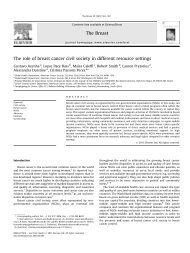3.1-TNM staging (Eniu)
3.1-TNM staging (Eniu)
3.1-TNM staging (Eniu)
You also want an ePaper? Increase the reach of your titles
YUMPU automatically turns print PDFs into web optimized ePapers that Google loves.
<strong>TNM</strong> <strong>staging</strong> and prognosisAlexandru <strong>Eniu</strong>, MD, PhDMedical OncologistDepartment of Breast TumorsCancer Institute Ion ChiricuţăCluj-Napoca, Romania
The Basics of <strong>TNM</strong> StagingPremises:– Cancers of the same anatomic site and histologyshare similar patterns of growth and similaroutcomes.– As the size of the primary tumor (T) increases,regional lymph node involvement (N) and/ordistant metastases (M) become more likely.
DiagnosisTHE ONLY CERTITUDE = PATHOLOGYAlways necessaryInsufficient for planning treatmentWe need– prognostic factors– predictive factors– targeted diagnosis
The Basics of <strong>TNM</strong> Staging<strong>TNM</strong> records the 3 significant events inthe life history of a cancer:– Local Tumor Growth (T)TX, Tis, T0, T1, T2, T3, T4– Spread to Regional Lymph Nodes (N)NX, N0, N1, N2, N3– Distant Metastasis (M)MX, M0, M1
The Basics of <strong>TNM</strong> StagingStage Grouping– After assignment of <strong>TNM</strong> categories– Stage 0, I, II, III or IVMultiple Simultaneous Tumors– The tumor with the highest T category is theone selected for classification and <strong>staging</strong>– Simultaneous bilateral cancers in paired organsare staged separatelyStaging of primary unknown tumors can bebased on clinical suspicion of the primaryorigin
Primary Tumor (T)Same definitions for clinical and pathologic TIf the measurement is made by physicalexamination, the examiner will use the majorheadings (T1, T2, or T3).If mammographic or pathologic measurementsare used, the subsets of T1 can be used. Tumorsshould be measured to the nearest 0.1 cmincrement.TXT0TisPrimary tumor cannot be assessedNo evidence of primary tumorCarcinoma in situ (DCIS, LCIS, Paget’s)Note: Paget’s disease associated with a tumor is classified according to the size of the tumor.
T1Tumor 2 cmor less ingreatestdimension
Primary Tumor (T)Subdivisions of T1 T1Tumor 2 cm or less in greatest dim. T1mic T1a T1b T1cMicroinvasion 0.1 cm or less in greatestdimensionTumor more than 0.1 cm but not morethan 0.5 cm in greatest dimensionTumor more than 0.5 cm but not morethan 1 cm in greatest dimensionTumor more than 1 cm but not morethan 2 cm in greatest dimension
T2Tumor more than2 cm but not morethan 5 cm ingreatestdimension
T3Tumor more than5 cm in greatestdimension
T4Tumor of any size withdirect extension to (a)chest wall or (b) skinT4a Extension to chest wall, notincluding pectoralis muscleT4b Edema (including peaud’orange) or ulceration of the skinof the breast, or satellite skinnodules confined to the samebreastT4cT4dBoth T4a and T4bInflammatory carcinoma
Inflammatorycarcinomavsneglected T4bT4dT4dT4b
Regional Lymph Nodes (N)Clinical NX Regional lymph nodes cannot be assessed (e.g.,previously removed) N0No regional lymph node metastasis N1 Metastasis to movable ipsilateral axillarylymph node(s) N2 Metastases in ipsilateral axillary lymph nodesfixed or matted, or in clinically apparent* ipsilateralinternal mammary nodes in the absence of clinicallyevident axillary lymph node metastasis– N2a Metastasis in ipsilateral axillary lymph nodes fixed toone another (matted) or to other structures– N2b Metastasis only in clinically apparent* ipsilateralinternal mammary nodes and in the absence of clinically evidentaxillary lymph node metastasisClinically apparent is defined as detected by imaging studies (excluding lymphoscintigraphy) orby clinical examination or grossly visible pathologically.
Regional Lymph Nodes (N)Clinical N3 Metastasis in ipsilateral infraclavicular lymphnode(s) with or without axillary lymph node involvement, orin clinically apparent* ipsilateral internal mammary lymphnode(s) and in the presence of clinically evident axillarylymph node metastasis; or metastasis in ipsilateralsupraclavicular lymph node(s) with or without axillary orinternal mammary lymph node involvement N3anode(s)Metastasis in ipsilateral infraclavicular lymph N3b Metastasis in ipsilateral internal mammary lymphnode(s) and axillary lymph node(s) N3cMetastasis in ipsilateral supraclavicular lymphnode(s)*Clinically apparent is defined as detected by imaging studies (excluding lymphoscintigraphy) or byclinical examination or grossly visible pathologically.
Regional Lymph Nodes (N)Pathologic (pN) pNX Regional lymph nodes cannot be assessed (e.g.,previously removed, or not removed for pathologic study) pN0 No regional lymph node metastasis histologically, noadditional examination for isolated tumor cells (ITC) pN1 Metastasis in 1 to 3 axillary lymph nodes, and/or ininternal mammary nodes with microscopic disease etectedby sentinel lymph node dissection but not clinically apparent** pN2 Metastasis in 4 to 9 axillary lymph nodes, or inclinically apparent* internal mammary lymph nodes in theabsence of axillary lymph node metastasis pN3 Metastasis in 10 or more axillary lymph nodes, or ininfraclavicular lymph nodes, or in clinically apparent* ipsilateralinternal mammary lymph nodes; or in ipsilateral supraclavicularlymph nodes
Distant Metastasis (M) MX Distant metastasis cannot be assessed M0 No distant metastasis M1 Distant metastasis
Breast Cancer StagingStage IStage 1N0T1
Stage IIa may also describe cancer in the axillary lymph nodes with noevidence of a tumor in the breastBreast Cancer StagingStage IIAStage IIAN1T1N1N0T2
Breast Cancer StagingStage IIBStage IIBN1T2N1N0T3
Breast Cancer StagingStage IIIB, IIICStage IIIBN0T4N1T4N1Stage IIICN3N2T4N2
Stage IV Breast CancerStage IV breast cancer can be any size andhas spread to distant sites in the body,usually the bones, lungs or liver, or chest wall
AJCC Staging System (anatomic)T N M Stage1 0 0 I0-2 0-1 0 IIa2-3 0-1 0 IIb0-3 1-2 0 IIIa4 or 0-1 1-2 0 IIIbAny 3 0 IIIcany any 1 IV
Survival in relation to presence and extent ofregional LNs
Breast Cancer Survival RatesStage 2yr 5yr% 10yr% %BCI 100 90 70 60II 90 70 55 30III 70 40 30IV (MBC) 25 2-5
How to ImplementAJCC <strong>TNM</strong> StagingDevelopment of policy and procedureStaging form part of the medical recordDevelopment of a process by which the<strong>staging</strong> form is placed in the medical record– Size of facility and number of analytic cases– Pathology, medical records, cancer registry…Development of Quality Control Methods toassure compliance
The <strong>TNM</strong> is imperfect!Prognostic factors– Lymph Node Involvement– Tumor Size– Tumor Grade– Lymphatic/Vascular/Perineural Invasion– Age of the patient– Tumor biology Profile* ER, PR*Her2neu expression*Ki 67/ proliferation fraction
Future of OncologyDiagnostic: Organ → Molecular EtiologyClassification: Histology → Molecular FunctionFocus: Therapy → PreventionTherapy: Toxic, Complex → Non-Toxic, TargetedOutcome prediction: Suboptimal → PrecisePatients follow-up : Anatomic → Systemic
Backup slides
Regional Lymph Nodes (N)Pathologic (pN) a pN0(i–) pN0(i+)clusterNo regional lymph node metastasishistologically, negative IHCNo regional lymph node metastasishistologically, positive IHC, no IHCgreater than 0.2 mm pN0(mol–) No regional lymph node metastasishistologically, negative molecularfindings (RTPCR) b pN0(mol+) No regional lymph node metastasishistologically, positive molecularfindings (RTPCR) b
Regional Lymph Nodes (N) aClassification is based on axillary lymphnode dissection with or without sentinellymph node dissection. Classification basedsolely on sentinel lymph node dissectionwithout subsequent axillary lymph nodedissection is designated (sn) for “sentinel node,”e.g., pN0(i+) (sn). bRT-PCR: reverse transcriptase/polymerasechain reaction.
Regional Lymph Nodes (N) pN1 pN1mi pN1a pN1b pN1cMetastasis in 1 to 3 axillary lymph nodes, and/or ininternal mammary nodes with microscopic diseasedetected by sentinel lymph node dissection but notclinically apparent**Micrometastasis (greater than 0.2 mm, nonegreater than 2.0 mm)Metastasis in 1 to 3 axillary lymph nodesMetastasis in internal mammary nodes withmicroscopic disease detected by sentinel lymphnode dissection but not clinically apparent**Metastasis in 1 to 3 axillary lymph nodes and ininternal mammary lymph nodes with microscopicdisease detected by sentinel lymph node dissectionbut not clinically apparent.** (If associated withgreater than 3 positive axillary lymph nodes, theinternal mammary nodes are classified as pN3bto reflect increased tumor burden)
Regional Lymph Nodes (N)Pathologic (pN) a pN2nodes, or inmammary lymphaxillary lymph node pN2aleast pN2bMetastasis in 4 to 9 axillary lymphclinically apparent* internalnodes in the absence ofmetastasisMetastasis in 4 to 9 axillary lymph nodes (atone tumor deposit greater than 2.0 mm)Metastasis in clinically apparent* internalmammary lymph nodes in the absence of axillarylymph node metastasis pN3Metastasis in 10 or more axillary lymphnodes, orin infraclavicular lymph nodes, or inclinicallyapparent* ipsilateral internalmammary lymphnodes in the presence of1 or more positive axillary lymph nodes; or in morethan 3 axillary lymphnodes withclinically negative microscopicmetastasis in internal mammary lymph nodes; or
Regional Lymph Nodes (N)Pathologic (pN) a pN3a Metastasis in 10 or more axillary lymph nodes(at least one tumor deposit greater than 2.0 mm),or metastasis to the infraclavicular lymph nodes pN3b Metastasis in clinically apparent* ipsilateralinternalmammary lymph nodes in the presenceof 1 ormore positive axillary lymphnodes; or in morethan 3 axillary lymphnodes and in internalmammary lymphnodes with microscopic diseasedetected bysentinel lymph node dissection but notclinicallyapparent** pN3cMetastasis in ipsilateral supraclavicularlymphnodes– *Clinically apparent is defined as detected by imaging studies (excludinglymphoscintigraphy) or by clinical examination.
Stage Grouping Stage 0 Tis N0 M0 Stage I T1* N0 M0 Stage IIA T0 N1 M0 T1* N1 M0 T2 N0 M0 Stage IIB T2 N1 M0 T3 N0 M0 Stage IIIA T0 N2 M0 T1* N2 M0 T2 N2 M0 T3 N1 M0 T3 N2 M0 Stage IIIB T4 N0 M0 T4 N1 M0 T4 N2 M0 Stage IIIC Any T N3 M0 Stage IV Any T Any N M1• Note: Stagedesignation may bechanged if post-surgicalimaging studies reveal thepresence of distantmetastases, provided thatthe studies are carriedout within 4 months ofdiagnosis in the absenceof disease progressionand provided that thepatient has not receivedneoadjuvant therapy.
Schematic Diagram of Breast andRegional Lymph NodesAJCC Cancer Staging Atlas











